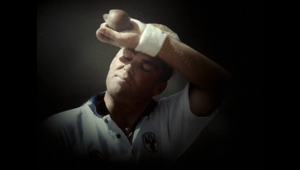
Rob Galluzzo’s FINCH is Home to Big Creative Experiments Like Dog Toys and Klaxon Horns

Creating a rainbow dog toy. Founding an education program to get more girls into STEM. Lobbying the government to legislate a minimum social media age. Buying a dog show. Convincing advertisers to commit a portion of their media spend to animal welfare. Patenting a Klaxon horn to fit onto a bottle of Pepsi.
Rob Galluzzo loves a grand experiment.
The CEO of FINCH has developed the production company into an incubator of sorts - imagining and inventing things far beyond ads. He starts by daydreaming on a problem, then questioning his daydream, then doing something about it: “You can't organise daydreams. You either ignore them or you act on them.”
“Probably within two minutes of hearing the problem, honestly, I tune out,” he tells LBB.
“I don't listen to the details. I start daydreaming about what it could look like and how it might unfold. And when I come out of that little daydream, often I've gone, 'Huh, I can see that.’
“I just get to it really quickly. If I can't daydream it, it doesn't mean it can't be done, it just means I probably can't get to it quickly enough to ask all the right questions, to watch it progress.”
One of the best examples of this process is an idea he had while tuning out a conversation with Nick Worthington, the former creative chair at Colenso, and one of the top 10 copywriters of all time according to D&AD.
“He had five ads he needed made, he only had 400 grand,” Rob recalls, “And I look across, and there's a bottle of Pepsi on his desk, and it had a weird lid on it. So, as I do, I stop listening, and I'm fascinated with this lid.
“I went, 'Oh, so it's a horn on a bottle of Pepsi'. And then I went, 'Oh, wow. He's captured the CO₂ in a bottle of Pepsi, and he's using it like a Klaxon horn. Oh my god, that is so smart.' And then I started getting annoyed. I'm like, 'I could have built that with him. He knows we've got Nakatomi [FINCH's technology arm] and why wouldn't he have called me in on something really interesting like that?' All of this is going on in my head. I'm starting to get annoyed with him privately.
“Anyway, we get to the end of the meeting, and I get up and it's just a melted lid. It literally was nothing. I apologised to him. I said, 'Oh, dude, I gotta apologise. I wasn't listening for the last 10 minutes of that, but I think I may have invented something.'
“I shared it with him, and he then went, 'Oh, what, like this?' And with a beautiful, creative, open brain, he sketched it. He gave it a name. He called it COToot on the spot.”
Rob sent the sketch, which he’s shared externally for the first time with LBB, to Nakatomi, and asked the team to make it. Nakatomi came back with bad news: it wouldn’t work. His staff said, “The engineers have done the numbers, it won't work. There's not enough pressure.”
“Normal people say, 'Okay.' But I went, 'Oh, I don't believe the engineers. How much do I have to pay for you to prove that it doesn't work?'”

Nick Worthington's sketch of COToot. Rob says he's never shared it externally before
The answer: $5,000. Rob told Nakatomi, “I'll spend the five grand. Show me it doesn't work.' And then it did work. And then we patented it, and then we partnered with Shane Warne, because the plan was Pepsi, horns, cricket, India ... He took 25% of the company and of COToot.
“The problem, really, is that I'm the worst person to have proven the engineers wrong, because now I don't believe anyone ... There's something unhealthy about that, and there's something exciting about the fact that I generally don't believe 'no'.”
Ultimately, COToot didn’t go anywhere. Rob felt strange about making “single use plastic things that make noise,” and world-renowned cricketer Shane Warne passed away. But it was “one of those expressions of daydream.”
“I have dozens of those stories, and they were all real, and they were all explorations.”
One of them is Creatable, an education disruptor in partnership with UNICEF. FINCH noticed a lack of women and girls applying for STEM-related roles; it escalated to become an initiative delivering STEM-based education in Africa’s Burundi, the poorest country in the world. The professional development course has rolled out to 1,000 students across 10 schools in 10 provinces.
The program has also worked with Beverly Hills Girls High School in Sydney’s south to train teachers in STEM skills.
Such a venture doesn’t feel out of place at FINCH, since the production company itself was a big bet. Rob says the market was already well-serviced by premium production agencies that had been around for a decade or more. He was told there wasn’t room for another.
“To break into that seemed hard, and then, all of a sudden, seemed easy, you know what I mean?”
Soon enough, the company was humming, but Rob wasn’t satisfied. He’d baked in compassion and imagination as foundational tenets of FINCH. He’d taught his team not to settle for curiosity, instead opting for adventure (which he says is curiosity plus action).
Rob has dyslexia and “probably ADHD”, and says he benefits when his brain has lots of projects to bounce between. But wanting more also serves a bigger purpose; by asking “What more could we be?” the agency’s leadership attracts the right talent and signals the calibre of its thinking to the market. Rob says he’s not the sole reason for that ambition, but “I have the privilege of being able to organise it.”
“At some point there is a leader that needs to climb to the top of that crow's nest and see where is land, and where is reasonably safe, at least read the lay of the land.”
Rob wanted to get close to a community to better-inform FINCH’s work, so decided to buy an audience. That’s how he came to co-own a dog show with Mars’ former global CMO, Bruce McColl. Investing in the Cat and Dog Lovers Festival gives FINCH behavioural data, human insights, and a point of view on what energises fandoms.
“What do we learn about everything from the way crowds move into buying patterns to where there are gaps in the market. And it gives us the courage to maybe design a new rainbow toy for dogs.”
That’s Rainbow-wow, another of FINCH’s experiments. Dogs can only see shades of blue and yellow, so the toy represents the full spectrum of canine colours, becoming the first real rainbow dogs can see. Rob has been talking to famous vet Dr Chris Brown about the venture.
The CEO's love of animals is a thread running through a number of his projects. In 2018, he launched the Cannes Grand Prix-winning The Lion’s Share, a program for brands to donate 0.5% of their media spend to animal welfare charities every time they feature an animal in their advertising (almost 1 in 5 campaigns do). Rob presented to the UN to get the United Nations Development Programme on board - it manages the program - and partnered with the likes of Sir David Attenborough and Shane Warne.
Then there’s ‘regular’ FINCH work, like its new reality TV show ‘The Big Trip’, in partnership with Innocean and Hyundai. Rob says the series represents FINCH’s goal to “build content that actually lives in culture”; the production company will do a road show with agencies to present its view on branded entertainment, “and show them what we think is next.” Achieving a breadth and depth of success isn’t easy, though.
“It's hard to be a company that makes really high quality TV commercials at scale, and a company that makes longform films that win Sundance, and a company that makes dog rainbows, and a company that builds Lion's Share and does 36 Months to change the government and then go and wrestle with network TV to get prime time, and then make a reality show that holds up.”
Earlier this month, 36 Months - led by Rob and radio presenter Michael ‘Wippa’ Wipfli - succeeded in its lobbying efforts to install a minimum social media age; the Australian government agreed teens should be 16 before they can access social platforms. Rob told LBB when the Prime Minister committed to passing the laws that it was an “emotional” moment for him.
He says he feels just as strongly about FINCH’s roster of directors as he does about the unorthodox projects swirling around the business.
“We've got some bloody interesting up and comers that are going to be real players in the marketplace ... there's just as much beauty and passion in watching a director find their voice and us help the market hear it.”
He wants those rising stars to be just as motivated by adventure and imagination as he is. Rob quips that “we probably talked about 3%” of the daydreams that have either been set alight or fizzled out.
“I don't think there'll ever be a moment where we don't ask, 'What more could we be?'”















